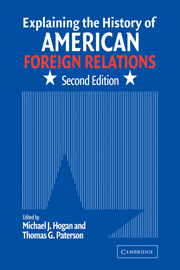Book contents
- Frontmatter
- Contents
- Preface to the Second Edition
- Contributors
- 1 Introduction
- 2 Defining and Doing the History of United States Foreign Relations : A Primer
- 3 Toward a Pluralist Vision : The Study of American Foreign Relations as International History and National History
- 4 Theories of International Relations
- 5 Bureaucratic Politics
- 6 Psychology
- 7 National Security
- 8 Corporatism
- 9 World Systems
- 10 Dependency
- 11 Considering Borders
- 12 The Global Frontier : Comparative History and the Frontier-Borderlands Approach
- 13 Modernization Theory
- 14 Ideology
- 15 Culture and International History
- 16 Cultural Transfer
- 17 Reading for Meaning : Theory, Language, and Metaphor
- 18 What's Gender Got to Do with It? Gender History as Foreign Relations History
- 19 Race to Insight: The United States and the World, White Supremacy and Foreign Affairs
- 20 Memory and Understanding U.S. Foreign Relations
- Index
9 - World Systems
Published online by Cambridge University Press: 05 June 2012
- Frontmatter
- Contents
- Preface to the Second Edition
- Contributors
- 1 Introduction
- 2 Defining and Doing the History of United States Foreign Relations : A Primer
- 3 Toward a Pluralist Vision : The Study of American Foreign Relations as International History and National History
- 4 Theories of International Relations
- 5 Bureaucratic Politics
- 6 Psychology
- 7 National Security
- 8 Corporatism
- 9 World Systems
- 10 Dependency
- 11 Considering Borders
- 12 The Global Frontier : Comparative History and the Frontier-Borderlands Approach
- 13 Modernization Theory
- 14 Ideology
- 15 Culture and International History
- 16 Cultural Transfer
- 17 Reading for Meaning : Theory, Language, and Metaphor
- 18 What's Gender Got to Do with It? Gender History as Foreign Relations History
- 19 Race to Insight: The United States and the World, White Supremacy and Foreign Affairs
- 20 Memory and Understanding U.S. Foreign Relations
- Index
Summary
[Every] capitalist development … seems, by reaching the stage of financial expansion, to have in some sense announced its maturity: it [is] a sign of autumn.
– Fernand BraudelWhen Mr. [Henry] Kissinger asked whether economic factors have ever controlled political, Mr. [George] Ball said … Economics will influence the political shape of the world since politics can only go so far in interrupting profit before strong pressure develops for a more suitable set of political rules.
– Council on Foreign Relations meeting, 1968The brilliant Adolf Berle once wrote in his diary: “There is order in the cosmos and if you can not apprehend it, then you make one up inside your head.” World systems theory (WST) is such an invention. And while it has both limits and flaws, as we shall see, it is a theory that transcends those deficits and offers historians a tool that is not only useful, but arguably essential in generating innovative categories, vocabulary, questions, paradigms, and insights. At its most general, its crucial advantage is its absolute insistence on locating any study within the temporal frame of long-term time and within the spatial context of a global unit of analysis. To do otherwise runs the risk of reinventing the wheel, of misinterpreting short-term trends as self-contained or unique when they are often merely segments of medium-term cycles or long-term secular tendencies.
- Type
- Chapter
- Information
- Explaining the History of American Foreign Relations , pp. 149 - 161Publisher: Cambridge University PressPrint publication year: 2004

